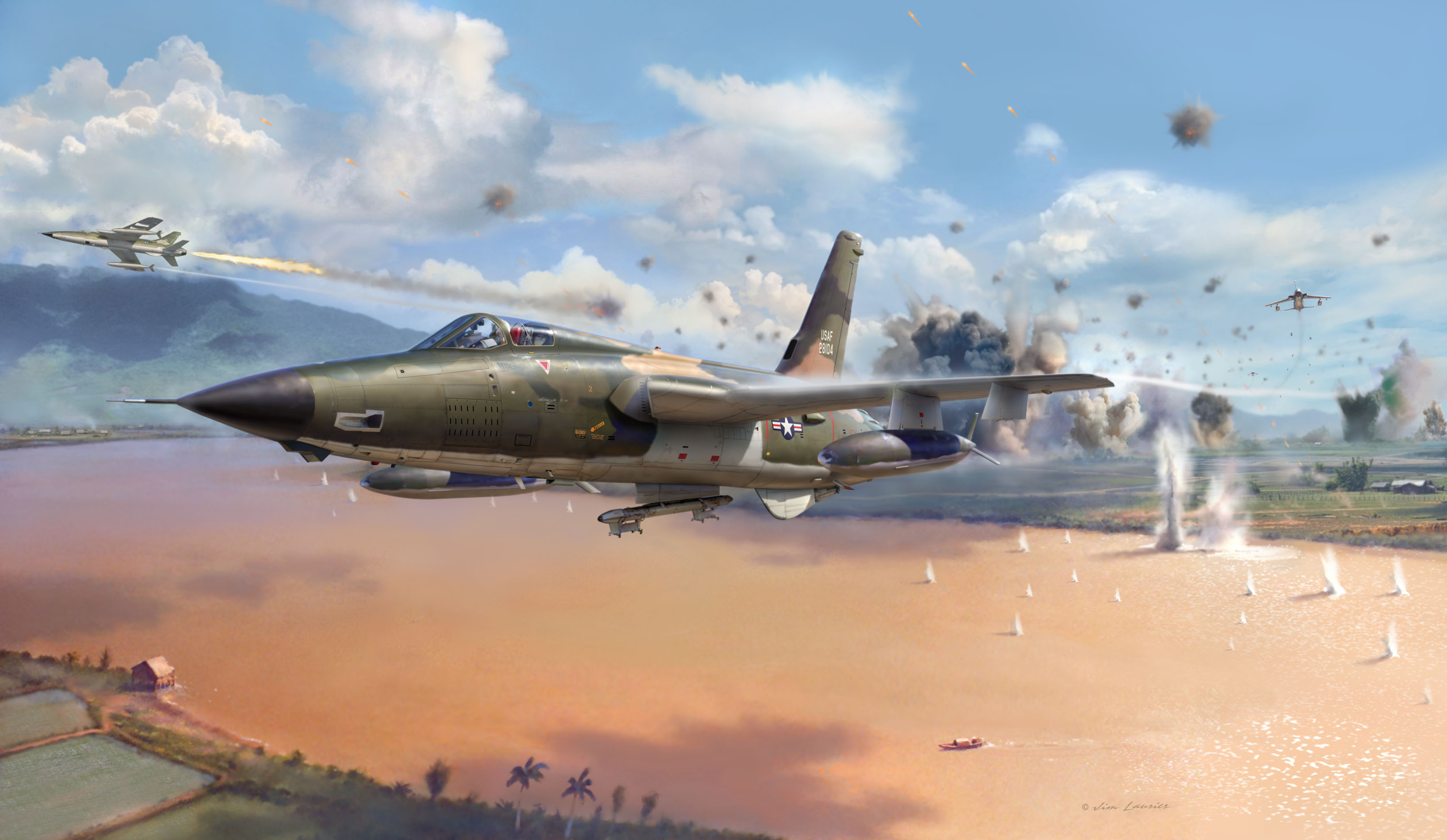Pilots loved the Thud. Except for test pilots, who were paid to find faults, the Republic F-105 Thunderchief seems to have had no detractors. Aviators as well as ground crews and maintainers graced the airplane with the kind of brand loyalty that is otherwise found among Coke drinkers, Harley riders and A-10 Warthog drivers (another Republic product).
“I just loved it from the moment I saw it,” said Captain Hank Goetz in the documentary Thud Pilots. “Everybody wanted to get their hands on it.” Colonel John Casper enthused: “Greatest airplane I’ve ever flown. It was a delight to fly, and I’ve flown the F-5, the F-4, the A-10, the F-16…but [the F-105] was the one I really loved flying.” Captain Sam Morgan: “There was nothing, with that airplane, that I couldn’t get out of. You could pull all the Gs you wanted, you could run as fast as you wanted, it was just a great airplane. And you looked good on the ladder.”
Thud pilot Vic Vizcarra called it “the Cadillac of the air. Huge, comfortable cockpit. I had all the confidence in the world in that airplane. It had terrain-avoidance radar, not terrain-following. You had to manually fly it. I remember one training mission I flew entirely under the [radar] bag. My instructor said, ‘Hey Vic, look where you are.’ I was in a tiny valley, huge mountains on each side. It proved to me I’ll be able to do this mission in real weather.”
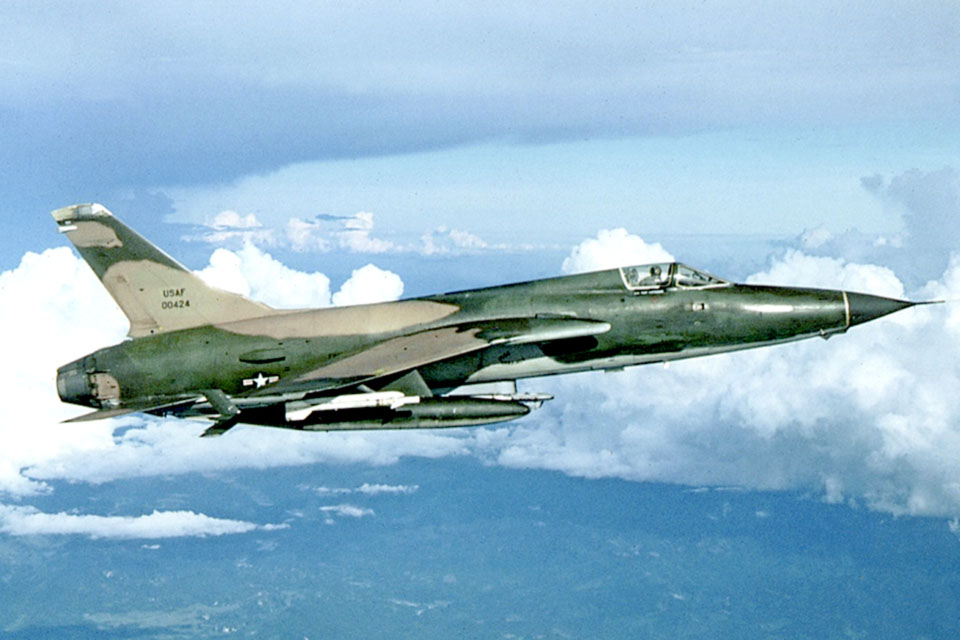
“It was a beautiful airplane, and it was a real thrill to fly,” said Colonel Calvin Markwood. And Marty Case, with 2,000 hours in Thuds, noted: “I really liked the cockpit layout. The pitot heat [switch] was unlike any other airplane. It had a little cube on the end of it, like an ice cube, so you’d feel around for that and you knew you had the pitot heat.”
Colonel Randolph Reynolds flew the F-105 in Vietnam as well as with the Air Force Reserve. “I loved the Thud and came to know its every nuance,” he wrote. “The cockpit was expansive….The stick in the Thud seemed directly linked to the rate of rotation of the nose, a control characteristic that made flying the airplane a joy.”
Some of the admiration probably wasn’t deserved. After all, the Thud was the only aircraft in Air Force history that had to be withdrawn from combat because nearly half the fleet had been shot down or crashed, leaving too few to be tactically useful. It also quickly failed as a Thunderbird team aircraft, when one broke in half during practice for only its seventh show. And the airplane’s design and gestation was a tortuous, troubled and controversial process.
“But for the challenge of the air war,” Colonel Jack Broughton wrote in Thud Ridge, “I guess the Thud would show up in most people’s book as a loser. But gradually, a startling fact became apparent—the Thud was getting to North Vietnam as nothing else could….The name that was originally spoken with a sneer has become one of utmost respect throughout the air fraternity.”
Nobody knows for sure where the nickname comes from. Some claim it can be traced back to the Howdy Doody character Chief Thunderthud, but that’s unlikely. The generally accepted explanation is that it’s the sound the airplane made when it hit the ground, as it too often did.
It could have been worse. The airplane’s original moniker was Ultra Hog. (The runway-eating Republic F-84 was the Hog, and the sweptwing F-84F became the Super Hog.) Some pilots called their F-105s Nickels, for the five designator. None called them Thunderchiefs.
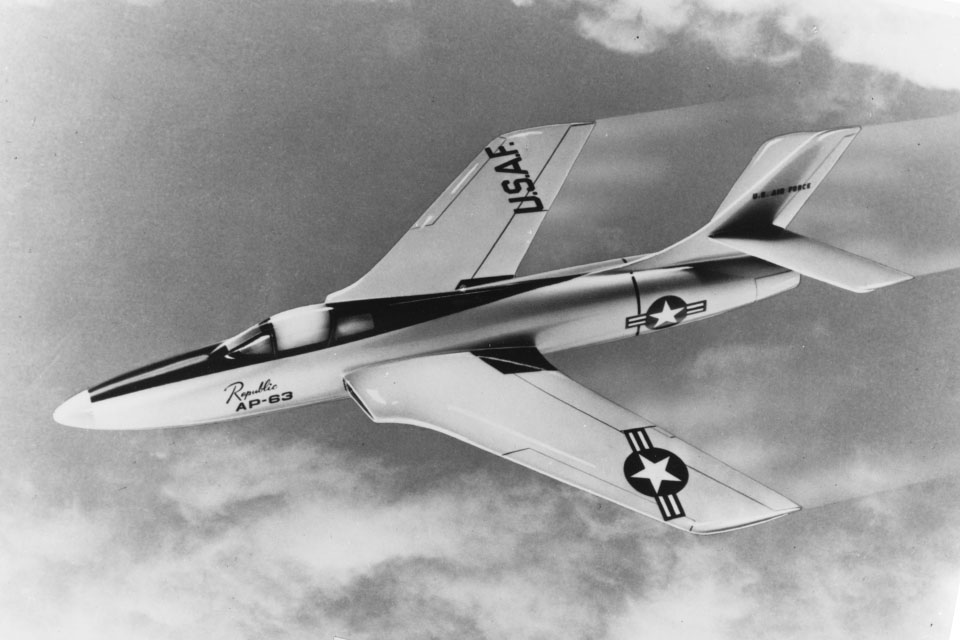
In 1951 Republic Aviation was looking at the end of its only contract, F-84 production, when it began work on an F-105 proposal. It had already been engineering what it would eventually call the XF-103, though that airplane never became more than a mockup. The F-103 was to be a Mach 3 bomber interceptor, rudely pushing the technology of the time with titanium skins and an imagined engine combining a turbojet with an afterburner that turned into a ramjet at high speeds.
The XF-103 mockup had one notable feature that would survive as a distinctive part of the F-105: its forward-swept ventral air intake. It became the two forward-swept wing-root inlets on the Thud.
The original YF-105 prototypes—there were two—had virtually nothing in common with the airplane’s final configuration, other than its rough dimensions: a fuselage as big as a railroad tank car; small, midmounted swept wings; tall landing gear to provide underbelly clearance for the fat nuclear weapon that the 105 was originally intended to carry; and conventional wing-root air intakes.
Those prototypes were entirely inadequate airplanes, barely able to bust the Mach, thanks to slab-sided fuselages and ordinary air intakes. Convair’s experience with the un-area-ruled F-102 pushed Republic to ask for help from the National Advisory Committee for Aeronautics. NACA’s Langley lab naturally recommended area ruling (the classic Coke bottle–shaped fuselage), which Republic design chief Alexander Kartveli resisted. He loved an airplane with smooth lines and had even protested the switch to a bubble canopy on the P-47D Thunderbolt, griping that it “looked like a pickle” atop the fuselage.
In the end, Kartveli accepted a modified version of NACA’s proposal, claiming that area ruling was effective only at transonic speeds. Whatever the case, his Thunderchief was now a Mach 2.15 airplane, at least some of that the result of its new, substantially more powerful Pratt & Whitney J75 engine, the King Kong of its day.
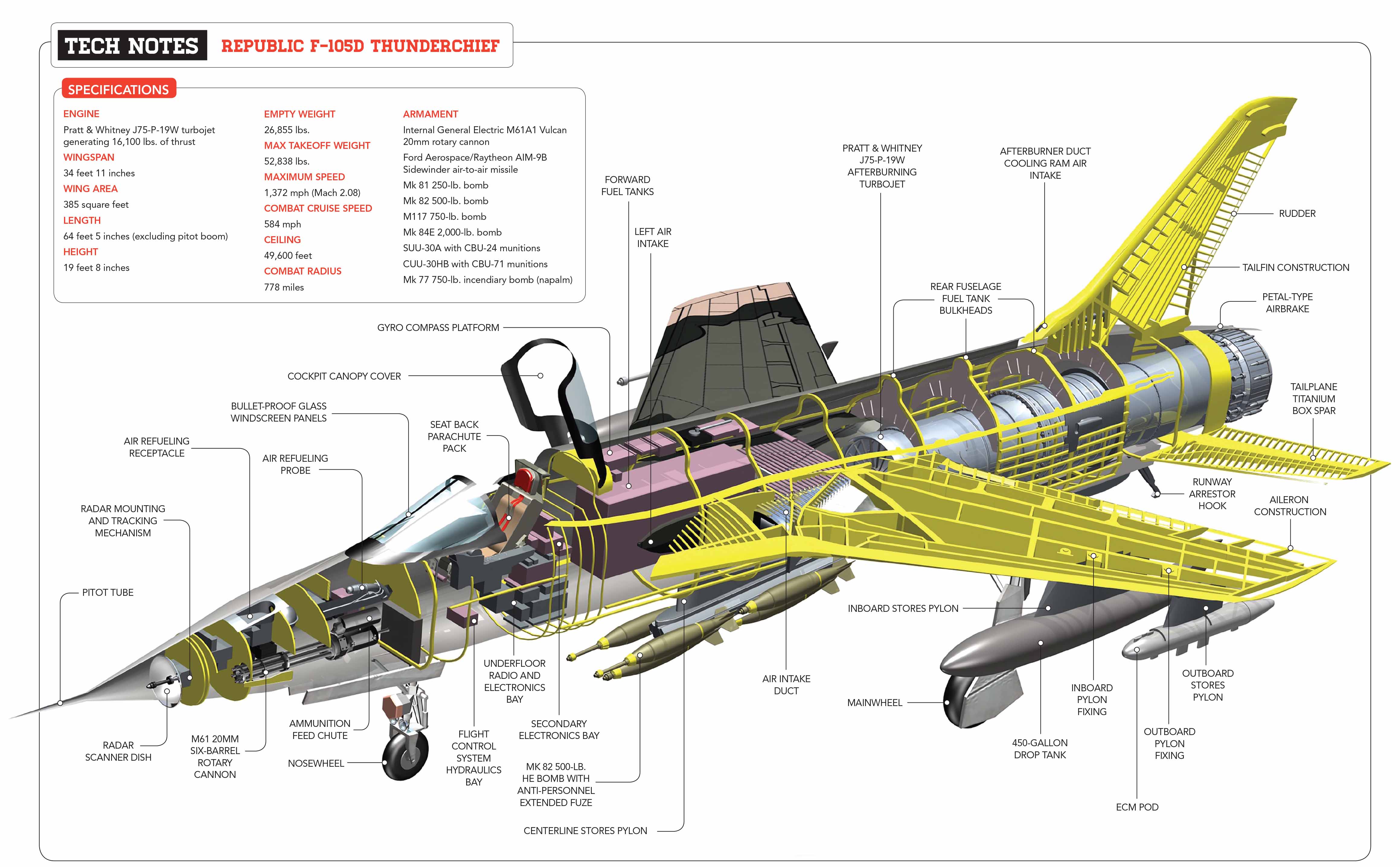
There never was an F-105A. Production went straight to the F-105B, which proved to be not ready for prime time, largely due to an inadequate fire-control system. But the B was fast. An F-105B set a world speed record in December 1959: 1,216 mph over a 62-mile circuit that required the pilot to maintain a precise course while pulling a steady 3.5 Gs for three minutes. Nor was there an F-105C, a proposed two-seat trainer. The first “real” 105 was the F-105D, the definitive model that quickly became the most-produced variant and the Vietnam War bomber we today know as the Thud.
Vietnam repurposed the F-105. The airplane that had been designed as a high-speed nuclear delivery van became a bomb truck, carting up to 16 750-pound iron bombs, many left over from World War II, into the most fiercely defended territory an air war had ever seen. Berlin’s 88s were child’s play compared to North Vietnam’s 8,000 radar-guided triple-A cannons plus the Soviet- and Chinese-run SAM sites and MiGs supported by a ground-control intercept system. “It was the grimmest contest yet conceived between sophisticated air and ground machinery and people,” wrote Jack Broughton.
That 1940s war apparently hadn’t left enough bombs, however. There was a bomb shortage, though the government denied it. Thuds sometimes launched carrying only two or three bombs, sent into peril simply to keep up the sortie count.
“Going downtown”—attacking Hanoi—became part of air war jargon, as did “Thud Ridge.” The infamous massif was a 15-mile-long, 5,000-foot-high line of mountains northwest of Hanoi that pointed straight at the city. Thud pilots used it as both a landmark and a largely ineffective shield from groundfire. Thud Ridge soon became paved with jettisoned drop tanks, empty weapons pylons and F-105 wreckage.
The Thud’s ordnance was carried on underwing and belly pylons and hardpoints, while the internal bomb bay housed a 390-gallon gas tank. The all-weather F-105D was the world’s first black-box fighter, as much electronic as it was mechanical. One-third of its total cost went into electronics, and they initially made it the only Air Force jet capable of penetrating North Vietnam’s Soviet-sourced defenses.
Thuds flew more than 75 percent of all the bombing sorties against North Vietnam. They were based at two fields in Thailand—Korat and Takhli—and it was a good 600 miles to most of their targets. Inflight refueling was often needed right after takeoff and climb, when six-ton loads and hot weather required partial fueling, and tankers were certainly needed for the run home. Against orders, KC-135s sometimes flew deep into North Vietnamese territory to rescue F-105s low on gas.
Whether the 3½-year bombing campaign, called Rolling Thunder, was worth the effort will forever be debated. There was little of value to hit in North Vietnam—no big factories or sprawling oil refineries, only small power plants, ordinary buildings, a few minor military installations and MiG airfields that were out of bounds according to the restrictive rules of engagement. “There wasn’t a target in Vietnam worth a -105,” wrote Victor Vizcarra. “‘One pass and haul ass,’ we used to say.”
Bridges might have been a useful target, particularly the robust Paul Doumer Bridge along the supply route from Haiphong Harbor to Hanoi. But the Thuds’ moderate-size, unguided bombs were ineffective against it, and their Bullpup air-to-ground missiles bounced off the Doumer’s thick French concrete.
Air-to-air combat was not encouraged by the Washington overseers. When an F-105 flamed a MiG-17 that had just killed another Thud early in the war, President Lyndon Johnson announced that he did not want any more MiGs shot down. It was too politically troublesome, and Johnson was afraid of starting World War III.
“It was a great airplane,” said one Thud pilot. “Not much of a fighter, but it was so much faster than everything else.” The 105 could go so fast down low that the canopy would start to soften or become opaque from the heat. But speed was its salvation, particularly when challenged by MiG-17s.
Even if it was “not much of a fighter,” Thuds did shoot down 27.5 MiG-17s (including one kill shared with an F-4 Phantom). Two of those victories were registered by Sidewinder heat-seeking missiles, but the rest of the North Vietnamese fell to the Thud’s 20mm Vulcan rotating-barrel cannon, an early version of the gun that would make Republic’s A-10 such a fearsome weapon.
The M61 Vulcan was a total update of a 90-year-old concept—the Gatling gun. The Lockheed F-104 was the first fighter to mount a Vulcan, and the Thud was the second. The F-105 carried about 11 seconds’ worth of 20mm ammunition, at close to 6,000 rounds per minute, but the Vulcan was fired in one- to three-second bursts.
For those 27.5 victories, the cost was seven F-105s downed by MiG-17s and 15 by MiG-21s. (There were no 105 kills against the dangerous Mach 2 MiG-21s.) MiG-17s had a hard time hosing Thuds. The MiGs vibrated badly when forced to the speeds needed to challenge a Thud, and the shaking dispersed their cannon rounds.
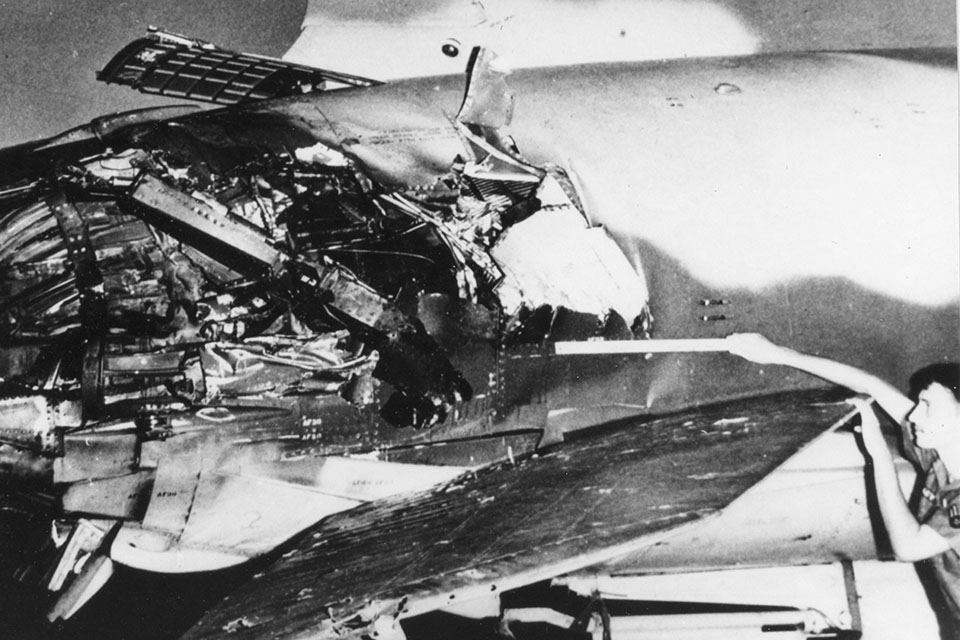
There’s a myth that the Thud “would always get you home,” and every pilot who made it back to base with a shot-up F-105 put another notch in that reputation. The airplane’s sheer bulk and presumed strength made it seem obvious that the Thud was a survivor. The Air Force, however, did a study and found that in fact few badly damaged 105s successfully returned to base.
“The curse of the Thud was that she would go like a dingbat on the deck and she would haul a huge load,” wrote Broughton, “but she was prone to loss of control when the hydraulic system took even the smallest of hits.” The stabilator would instantly move to a full nose-down position when hydraulic pressure was lost, and at low altitudes that was often unsurvivable.
The 105’s main fuel tanks were mounted atop the big, hot J75 engine, like saddlebags, since there was no room for fuel in the thin wings. A piece of SAM shrapnel (SAMs were proximity-fuzed and didn’t have to score a direct hit) could easily hole a tank and create a fireball.
Like its predecessor the P-47, the F-105D was a monster. Not only did the airplane carry a bigger bombload than a Boeing B-17, its fuselage was only 10 feet shorter than that of a Flying Fortress, and the cockpit was so far off the ground that the boarding ladder was tall enough for suburban gutter-cleaning. At 53,000 pounds max gross, it was the heaviest single-seat, single-engine airplane in the world until the advent of the 70,000-pound Lockheed Martin F-35.
Though it had a gun, the F-105 was never intended to be a fighter. It probably should have been designated A-for-attack. Its small, highly swept and loaded wings helped make it superfast and stable down low, but at the cost of maneuverability. The Thud was a bomber from the outset, and its large internal bay was a first for fighters. (The Convair F-102 had three small weapons bays in its belly, but they held only missiles, not bombs.)
That hold was intended for a nuclear weapon “about the size of a mansion-grade hot-water heater,” in the words of aviation writer Carl Posey. For the F-105 had a single, suicidal mission: Carry a nuclear bomb as deep as possible into the Soviet Union, at a speed so fast nobody could stop you, and then kiss your ass goodbye. Even if the pilot survived the initial blast, there wouldn’t be enough fuel aboard to get him home. And home was almost certainly a pile of cinders anyway, if a nuclear war was underway.
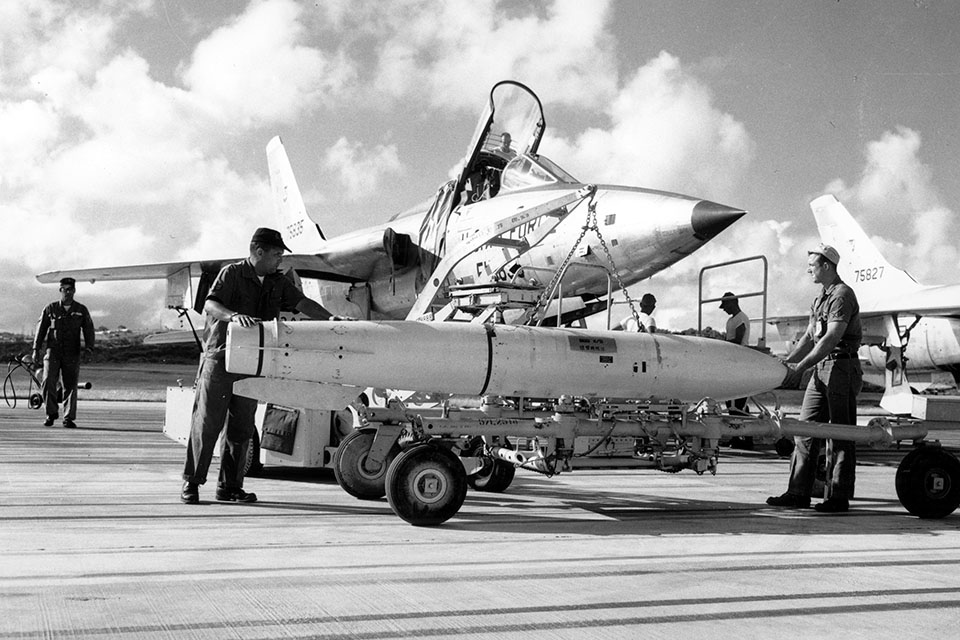
Thud pilots practiced a toss-bombing maneuver that sent the nuke targetward from the midpoint of an Immelmann maneuver, the theory being that it would take couple of minutes for the bomb to finish its parabola toward the target, and meanwhile you’d already be heading west with the afterburner lit. It is doubtful this reassured many pilots.
The supersonic Thud inevitably created sonic booms. The Air Force considered using the overpressure waves as tactical weapons—to disable delicate electronic equipment or clear minefields—but the most notorious F-105 boom occurred at the U.S. Air Force Academy, as part of a ceremony in May 1968. After a low-level flyover by four F-105Ds, one pilot during a solo pass failed to account for the thin air at the academy’s 6,000-foot altitude and blew over the assembled cadets at the speed of heat 100 feet off the ground. He did a quarter million dollars in damage, most notably some 300 broken windows, and 15 people were cut by flying glass. A sign was soon posted: “Air Conditioning Courtesy of Republic Aviation.”
The F-105F was the first production two-seat Thud. It was intended to be a trainer, since the F-105D had grown so heavy that it was no longer a good idea to introduce pilots to the Thud by having them solo a single-seater, particularly since many new guys were coming from Strategic Air Command bombers and tankers and may never have flown a fighter. By the late 1960s, Tactical Air Command was using brand-new second lieutenants fresh from flight training.
The F and follow-on G model found their calling, however, in an entirely unexpected arena: as “Wild Weasels,” the two-seaters that would seek out SAM site targeting-radar signals and then destroy the site. The original Wild Weasels were F-100F Super Sabre hunters accompanied by bomb- and rocket-laden F-105Ds to do the killing, but the Huns couldn’t keep up with their 105 partners.
If SAMs were launched at a Wild Weasel, it was the backseater’s job to track them on a tiny, two-square-inch cathode-ray tube and call out maneuvering measures to the pilot. The usual SAM-avoidance maneuver was to wait until the missile was danger close—about a mile—and then perform a 4G pitchout that broke its radar lock.
The mission was encapsulated by many bears (as the electronics officers were called) who said: “Let me get this straight. You’re gonna put me in the back seat with some crazy-ass fighter pilot while I troll for SAMs? You gotta be sh—ing me.” The motto of the Wild Weasels, spelled out on their unit patches, became YGBSM.
It was no joke. At one point, Wild Weasels were being shot down faster than new crews could be organized and trained. Just two Medals of Honor were awarded to Thud pilots during the Vietnam War. Both went to Wild Weasels.
Eight hundred and thirty-three F-105s were manufactured between 1956 and 1965. During the Vietnam War, 395 were lost. In the course of the Thud’s career, 612 were destroyed by various causes—three-quarters of the entire production run. The F-105 had the highest noncombat accident rate of any USAF fighter. By 1970, the Air Force had withdrawn the F-105D from combat, though the Wild Weasels soldiered on until the end of the war.
Ninety-six F-105s remain relatively intact in museums, on display at various Air Force bases or awaiting destruction at the Davis-Monthan boneyard in Arizona. Not a one is flyable. In 2010 the Collings Foundation did its best to buy an F-105 that it could restore to flight, but the Air Force refused to provide one, citing liability concerns. Flyable Vietnam-era airplanes such as Collings’ F-4 have all been acquired from foreign sources, but no Thud ever flew under a foreign flag.
Does Collings plan to try again? “There’s very little chance it would be an option for us or anybody else,” a Collings representative said. “There are very few that could be returned to flight, and most of those, they cut the tails off to make sure they would never fly again.”
Contributing editor Stephan Wilkinson recommends for further reading: Thunderchief: The Complete History of the Republic F-105, by Dennis R. Jenkins; Republic F-105 Thunderchief, by Jaroslaw Dobrzynski and Marcelo Ribeiro; Republic F-105 Thunderchief, by David A. Anderton; Thud Ridge, by Jack Broughton; and Thud Pilot, by Victor Vizcarra.

